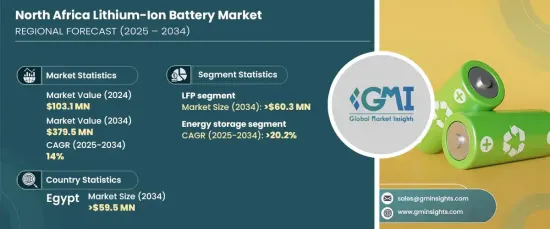PUBLISHER: Global Market Insights Inc. | PRODUCT CODE: 1666993

PUBLISHER: Global Market Insights Inc. | PRODUCT CODE: 1666993
North Africa Lithium-Ion Battery Market Opportunity, Growth Drivers, Industry Trend Analysis, and Forecast 2025 - 2034
North Africa Lithium-Ion Battery Market was valued at USD 103.1 million in 2024 and is projected to grow at a robust CAGR of 14% through 2034. This growth is primarily driven by the region's increasing focus on renewable energy initiatives aimed at improving energy security and addressing climate change challenges. Countries such as Egypt, Morocco, and Tunisia are making substantial investments in solar and wind power projects, which require efficient energy storage systems. Lithium-ion batteries, known for their high energy density, extended cycle life, and declining costs, are emerging as a reliable solution for balancing supply and demand in renewable energy systems. These batteries play a critical role in ensuring consistent power delivery, particularly in remote areas with limited access to the grid.

The surging adoption of consumer electronics and the gradual rise of the electric vehicle (EV) market are additional factors driving demand for lithium-ion batteries in North Africa. Urbanization and a growing middle class have led to increased use of portable devices like smartphones and laptops, necessitating advanced battery technologies. While still in its nascent stage, the EV market is gaining traction as governments implement incentives and invest in infrastructure to promote sustainable mobility solutions.
| Market Scope | |
|---|---|
| Start Year | 2024 |
| Forecast Year | 2025-2034 |
| Start Value | $103.1 Million |
| Forecast Value | $379.5 Million |
| CAGR | 14% |
By chemistry, the market includes LFP, LCO, LTO, NMC, NCA, and LMO segments. Among these, the LFP segment is expected to generate USD 60.3 million through 2034, driven by its adoption in renewable energy projects, industrial applications, and electric mobility. The safety, long cycle life, and thermal stability of LFP batteries make them particularly well-suited for use in harsh climates and industrial settings. Countries like Morocco, Egypt, and Tunisia are increasingly integrating LFP batteries into solar and wind energy systems to meet energy security and sustainability objectives.
The market is also categorized by applications, including industrial, automotive, consumer electronics, and energy storage. The energy storage segment is projected to grow at a CAGR of 20.2% through 2034, fueled by expanding renewable energy capacities and the need to stabilize intermittent power supplies from solar and wind projects. Demand for energy storage is further bolstered by efforts to provide reliable power access in off-grid and remote areas, supported by government policies and international funding for clean energy solutions.
Egypt lithium-ion battery market is set to generate USD 59.5 million through 2034. The country's emphasis on renewable energy integration, particularly in solar projects, is driving growth. Lithium-ion batteries are increasingly deployed in energy storage systems to address grid instability and support rural electrification, while rising demand for consumer electronics and EVs further accelerates market expansion.
Table of Contents
Chapter 1 Methodology & Scope
- 1.1 Market definitions
- 1.2 Base estimates & calculations
- 1.3 Forecast calculation
- 1.4 Data sources
- 1.4.1 Primary
- 1.4.2 Secondary
- 1.4.2.1 Paid
- 1.4.2.2 Public
Chapter 2 Industry Insights
- 2.1 Industry ecosystem analysis
- 2.2 Regulatory landscape
- 2.3 Industry impact forces
- 2.3.1 Growth drivers
- 2.3.2 Industry pitfalls & challenges
- 2.4 Growth potential analysis
- 2.5 Porter's Analysis
- 2.5.1 Bargaining power of suppliers
- 2.5.2 Bargaining power of buyers
- 2.5.3 Threat of new entrants
- 2.5.4 Threat of substitutes
- 2.6 PESTEL Analysis
Chapter 3 Competitive landscape, 2024
- 3.1 Strategic dashboard
- 3.2 Innovation & sustainability landscape
Chapter 4 Market Size and Forecast, By Chemistry, 2021 – 2034 (USD Million)
- 4.1 Key trends
- 4.2 LFP
- 4.3 LCO
- 4.4 LTO
- 4.5 NMC
- 4.6 NCA
- 4.7 LMO
Chapter 5 Market Size and Forecast, By Component, 2021 – 2034 (USD Million)
- 5.1 Key trends
- 5.2 Cathode
- 5.3 Anode
- 5.4 Separator
- 5.5 Electrolyte
- 5.6 Aluminum foil
- 5.7 Copper foil
- 5.8 Others
Chapter 6 Market Size and Forecast, By Application, 2021 – 2034 (USD Million)
- 6.1 Key trends
- 6.2 Industrial
- 6.2.1 Military
- 6.2.2 Heavy industrial equipment
- 6.2.3 Medical
- 6.2.4 Marine
- 6.2.5 Others
- 6.3 Automotive
- 6.3.1 HEV
- 6.3.2 BEV
- 6.4 Consumer electronics
- 6.5 Energy storage
Chapter 7 Market Size and Forecast, By Country, 2021 – 2034 (USD Million)
- 7.1 Key trends
- 7.2 Egypt
- 7.3 Libya
- 7.4 Morocco
- 7.5 Tunisia
- 7.6 Algeria
Chapter 8 Company Profiles
- 8.1 BYD
- 8.2 Exide Industries
- 8.3 General Electric
- 8.4 Hitachi Energy
- 8.5 Koninklijke Philips
- 8.6 Panasonic
- 8.7 Toshiba




